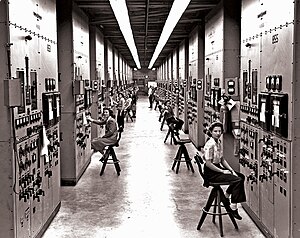Calutron Girls
The Calutron Girls were a group of young women—mostly high school graduates—who had joined the Manhattan Project at the Y-12 National Security Complex located at Oak Ridge, Tennessee, from 1943 to 1945.
Although they were not allowed to know at the time, they were monitoring dials and watching meters for calutrons, mass spectrometers adapted for separation of uranium isotopes for the development of nuclear weapons for use during World War II.
During World War II, the United States established the Manhattan Project to develop nuclear weapons.
[1] The Y-12 factory was built in Oak Ridge, Tennessee, to house 1,152 calutrons, a machine used for isotope separation.
[2][3] Local women were recruited because they were readily available, accustomed to hard work and were expected not to ask excessive questions and to be loyal and docile.
[4] The Tennessee Eastman Company, which ran the Y-12 site, recruited around 10,000 local women between 1943 and 1945 to operate the calutrons.
They proposed to train operators with only a high school education, and they used a large local advertising campaign to recruit workers.
[5][6] Reasons for applying included needing the money, having few other employment opportunities, youthful wanderlust, and wanting to help the war effort.
[6] The workers sat on high stools for 8-hour shifts, seven days per week, monitoring gauges and adjusting knobs to keep the needles where they were supposed to be and recording readings.
Kenneth Nichols compared production data for units and pointed out to Lawrence that the young ”hillbilly” girl operators were outproducing his scientists.
[15][16] On August 6, 1945, when the US dropped the first bomb, "Little Boy," on Hiroshima, Japan, the Calutron Girls were finally told what they had been working on.
[5] Some women were working and others were in their dorm rooms when someone came and told them that an atomic bomb had been dropped on Japan, and everyone there had played a part in making it.
Some, such as Huddleston, regularly shared their stories with the public, often alongside Oak Ridge historian Ray Smith.


